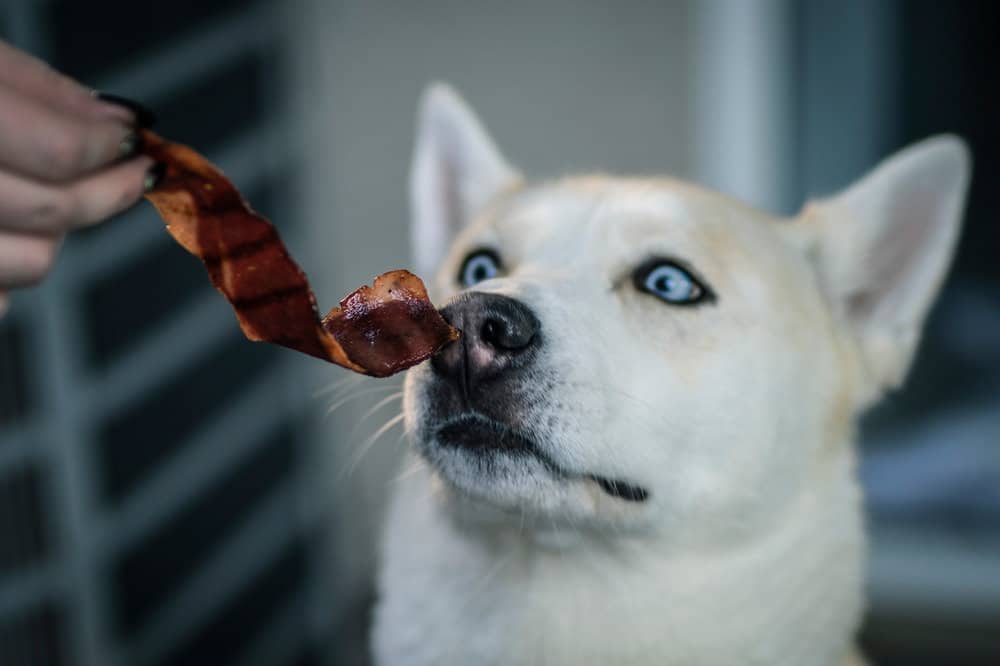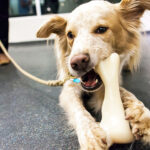When it comes to treating our furry friends, few snacks are as universally loved as bacon. The crispy, savory delight often elicits excited tail wags and pleading puppy eyes. But as much as we might want to share this delectable food with our dogs, it’s important to understand how to do so safely. While bacon can be a tasty reward, moderation is key to ensuring your pet stays healthy and happy.
In this article, we’ll explore how often you can safely feed your dog bacon, the potential risks involved, and some helpful guidelines to keep in mind for responsible snacking. Let’s dive into the juicy details and make sure our four-legged companions enjoy their treats without compromising their well-being!
Table of Contents
- Understanding Bacons Benefits and Risks for Dogs
- Determining the Right Portion Size for Your Furry Friend
- Healthy Alternatives to Bacon for Treating Your Dog
- Creating a Balanced Diet While Enjoying Occasional Treats
- Q&A
- Future Outlook

Understanding Bacons Benefits and Risks for Dogs
When it comes to treating your furry friend, bacon can be an enticing option that many pet owners consider. Bacon offers a rich source of protein and essential fatty acids, which can provide some nutritional benefits for dogs. However, it’s important to remember that moderation is key. Too much bacon can lead to weight gain due to its high fat content, and the sodium levels can be a concern as well. Regularly feeding your dog bacon could contribute to serious health issues like pancreatitis or obesity, making it crucial to limit their bacon intake to very occasional treats.
To ensure that your dog enjoys bacon safely, consider these guidelines for feeding:
- Always choose cooked bacon over raw to eliminate the risk of harmful bacteria.
- Opt for leaner cuts to reduce fat and sodium content.
- Cut bacon into small, manageable pieces to prevent choking hazards.
- Monitor your dog for any adverse reactions after feeding bacon, such as digestive upset.
In addition, consult with your veterinarian about your dog’s dietary needs and how bacon fits into their overall nutrition. Keeping these tips in mind can help you ensure that your canine companion enjoys bacon responsibly.
Determining the Right Portion Size for Your Furry Friend
When it comes to treating your dog with bacon, understanding the right portion size is crucial for their health. While bacon can be a delicious indulgence for your furry friend, it is important to remember that moderation is key. Too much bacon can lead to weight gain, pancreatitis, and other health issues. A good rule of thumb is to keep treats, including bacon, to no more than 10% of your dog’s daily caloric intake. For example, if your dog requires 500 calories a day, then only 50 calories should come from treats. This ensures that your pup enjoys their snack without overindulging.
To help you determine the proper amount of bacon to offer, consider the following guidelines:
Small dogs: 1/4 slice of cooked bacon
Medium dogs: 1/2 slice of cooked bacon
Large dogs: 1 slice of cooked bacon
Additionally, always opt for cooked bacon with no added seasonings or fillers, as these can be harmful to dogs. It’s also wise to monitor your dog after they have had bacon to ensure they don’t experience any adverse reactions, such as upset stomach or lethargy. Gradually introducing bacon to their diet can help you gauge their tolerance and preference, making it a fun treat-time experience for both of you!
Healthy Alternatives to Bacon for Treating Your Dog
If you’re looking to swap out bacon for healthier treats that your furry friend will love, there are plenty of options that are just as tasty without the added fat and sodium. Some excellent alternatives include:
Turkey Bacon: A leaner option that still packs a flavorful punch.
Chicken Jerky: High in protein and easy to chew, perfect for training treats.
Vegetable Chips: Dehydrated sweet potatoes or carrots can satisfy the crunch your dog craves.
Salmon Treats: Omega-3 rich and great for maintaining a shiny coat.
When choosing healthier snacks, always ensure they are made from quality ingredients. Incorporating fruits and vegetables can also be a great way to treat your pup. Consider the following options that dogs typically adore:
| Fruit/Vegetable | Benefits |
|---|---|
| Blueberries | High in antioxidants and vitamins. |
| Carrots | Good for dental health and low in calories. |
| Apples (without seeds) | Rich in vitamin C and a good source of fiber. |
| Pumpkin | Great for digestion and full of nutrients. |
Creating a Balanced Diet While Enjoying Occasional Treats
Ensuring your furry friend enjoys a varied and balanced diet is key to their overall health, but that doesn’t mean they can’t indulge in the occasional treat. When considering bacon as a treat, moderation is crucial. Bacon is often high in fat and salt, which can lead to various health issues in dogs if consumed excessively. As a general guideline, it’s recommended to limit treats like bacon to no more than 10% of your dog’s daily caloric intake. Keeping this in mind can help you find the right balance between their essential nutrients and the deliciousness they crave.
To maintain that balance, consider these helpful tips when incorporating treats into your dog’s diet:
Frequency: Offer bacon as an infrequent reward—perhaps once a week or during special occasions.
Portion Control: Offer only small pieces so you can control the amount of fat and salt your dog consumes.
Alternative Treats: Experiment with healthier alternatives like cooked chicken or vegetables for a low-calorie snack.
Here’s a simple breakdown of some treat options:
| Type of Treat | Frequency | Notes |
|---|---|---|
| Bacon | Once a week | High in fat; use sparingly. |
| Cooked Chicken | 2-3 times a week | Lean protein; a great alternative. |
| Carrots | Daily | Low-calorie snack; great for dental health. |
Q&A
Q1: Can I give my dog bacon as a treat?
A1: Yes, you can give your dog bacon as a treat, but it should be done in moderation. While many dogs enjoy the taste of bacon, it is high in fat and salt, which can lead to health issues if consumed in large amounts.
Q2: How often is it safe to give my dog bacon?
A2: Ideally, bacon should be an occasional treat and not a regular part of your dog’s diet. Depending on your dog’s size, activity level, and overall health, a small piece of cooked bacon once a week is generally a safe guideline. Always consult with your vet for personalized advice.
Q3: What are the potential risks of feeding my dog bacon?
A3: The main risks associated with bacon include obesity, pancreatitis (inflammation of the pancreas), and high sodium intake, which can lead to dehydration or more serious health issues. It’s important to monitor your dog for any adverse reactions after they eat bacon.
Q4: Are there any healthier alternatives to bacon for dog treats?
A4: Yes! There are plenty of healthier alternatives. Consider lean meats like chicken or turkey, vegetables like carrots and green beans, or commercially prepared dog treats that are lower in fat and calories. These options can be just as satisfying for your furry friend.
Q5: How should I prepare bacon if I decide to give it to my dog?
A5: If you choose to give your dog bacon, make sure it is well-cooked and cut into small, manageable pieces to prevent choking. Avoid giving them bacon with added seasonings or preservatives, as these can be harmful to dogs.
Q6: My dog really loves bacon. What if they beg for it frequently?
A6: It’s natural for dogs to beg for food, especially if they enjoy the taste of bacon. You can train your dog to reduce begging by offering them healthy treats instead and rewards for good behavior. Consistency is key to changing their habits!
Q7: What should I do if my dog eats too much bacon?
A7: If your dog accidentally consumes a large amount of bacon, monitor them closely for signs of distress, such as vomiting, diarrhea, or lethargy. If any of these symptoms occur, or if you’re concerned about your dog’s health, contact your veterinarian for guidance.
Q8: Are there specific dog breeds that should avoid bacon altogether?
A8: While all dogs can develop health issues related to high-fat foods, breeds that are more prone to pancreatitis, such as Cavalier King Charles Spaniels or Dachshunds, should particularly avoid bacon. Always consult your veterinarian if you’re unsure about your dog’s dietary needs.
Q9: Can puppies eat bacon?
A9: Puppies have sensitive digestive systems and should have a balanced diet specifically formulated for their age. It’s best to avoid giving puppies bacon until they are older and have a more developed digestive system. Always consult with your veterinarian before introducing any new foods to your puppy’s diet.
Q10: What’s the bottom line on feeding my dog bacon?
A10: Bacon can be a tasty treat for your dog, but moderation is essential. Stick to small portions and infrequent servings, and always prioritize your dog’s overall health and well-being. When in doubt, consult with your veterinarian to create a safe and enjoyable treat plan for your furry friend!
Future Outlook
while your furry friend may absolutely love the taste of bacon, it’s essential to treat this savory snack with caution. Moderation is key! By following the guidelines outlined in this article, you can safely incorporate bacon into your dog’s diet as an occasional treat, ensuring it remains a delightful surprise rather than a daily staple. Always remember to consider your dog’s individual health needs, consult with your veterinarian if in doubt, and monitor their reactions to new treats. With a thoughtful approach, you can keep those tails wagging while maintaining their health and happiness. So go ahead, share the love—just make sure your dog enjoys bacon in a way that’s safe and beneficial for them! Happy snacking!















